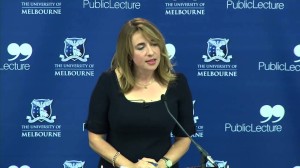New digital information age has set us back 500 yrs, to town square rumour

Katherine Viner, then editor of Guardian Australia, delivering the AN Smith lecture in Melbourne in 2013 on journalism in the age of the open web
In October 2013, Katherine Viner, who’s been appointed The Guardian’s new chief editor, described the changing contours of the information industry as follows:
It’s gone from being fixed to free-flowing and in some ways the new, digital age is a regression. In “the post-print era, we are returning to an age when you’re as likely to hear information, right or wrong, from people you come across,” she said. And she quotes Danish academic Thomas Pettitt whose theory is called the Gutenberg Parenthesis, which argues that the 500 years after Gutenberg’s invention of the printing press – those centuries of print-dominated information – were a pause.
Now, says Mr Pettitt, the web is returning us to a pre-Gutenberg state and the way we get news and views is, Ms Viner writes, “reminiscent of a medieval peasant, based on gossip, rumour and conversation.”
Once again, “we are defined by oral traditions: flowing and ephemeral.”
She reinforces the point by quoting Dick Costolo, the CEO of Twitter, who reaches back to the agora in ancient Greece to describe the way we’re passing news and information around today. The sort of exchanges we have through social media, the snippets we pick up, the lack of a reliable authoritative instant source is similar, Mr Costolo suggests, as the sort of rumour mill that operated in that ancient gathering place. He describes it as the “unfiltered, multi-directional exchange of information”.
This sounds like much more than being smart and catchy. It does make sense. And her prescription for the post-web age of journalism makes eminently good sense too. Ms Viner says the digital agora calls for even more journalism, real reporting, real stories, not just the “churnalism”, which is to say “rewriting wires, press releases and each other” and chasing the same sort of pointless things as a pack.
As an example, she points to the “famous photograph of the new Prince George emerging from hospital, with hundreds of photographers and reporters looking at him.” And she asks: “What would have happened if all but, say, three of them had been off doing something else? What bounteous other stories were we missing that day? If we’re not careful, photographs like these will be our industry’s epitaph.”

